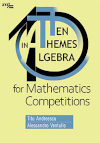- About MAA
- Membership
- MAA Publications
- Periodicals
- Blogs
- MAA Book Series
- MAA Press (an imprint of the AMS)
- MAA Notes
- MAA Reviews
- Mathematical Communication
- Information for Libraries
- Author Resources
- Advertise with MAA
- Meetings
- Competitions
- Programs
- Communities
- MAA Sections
- SIGMAA
- MAA Connect
- Students
- MAA Awards
- Awards Booklets
- Writing Awards
- Teaching Awards
- Service Awards
- Research Awards
- Lecture Awards
- Putnam Competition Individual and Team Winners
- D. E. Shaw Group AMC 8 Awards & Certificates
- Maryam Mirzakhani AMC 10 A Awards & Certificates
- Two Sigma AMC 10 B Awards & Certificates
- Jane Street AMC 12 A Awards & Certificates
- Akamai AMC 12 B Awards & Certificates
- High School Teachers
- News
You are here
Ten Themes in Algebra for Mathematics Competitions

Buy Now:
Publisher:
AMS
Publication Date:
2022
Number of Pages:
307
Format:
Paperback
Price:
59.95
ISBN:
978-1-7358315-5-8
Category:
Problem Book
[Reviewed by , on ]
Russel Jay Hendel
03/20/2023
This book reviews ten major techniques useful in solving mathematical problems. It should be of use to mathematics competition candidates, problem writers, problem solvers, and researchers.
The book form facilitates mastery of these techniques: The first 40% of the book presents brief but concise exposition of theory accompanied by practice problems while the last 60% of the book provides illustrative worked-out solutions to the problems.
I would divide the book into four parts:
- Review: Three chapters review basic high-school algebra: The quadratic formula, Vietta’s formula, completing the square, including the positivity of all squares, the arithmetic of complex numbers focusing on the interaction between the four basic operations, absolute value, and conjugation as well as De Moivre’s formula.
- Factorization Identities: Three chapters review three basic factorization identities: i) the closure of sums of squares under products (Lagrange’s Identity), ii) the factorization of \( a^{4} + 4b^{4} \) (Sophie Lorraine’s trick), and iii) the factorization of \( a^{3}+b^{3}+c^{3}-3abc \).
- Special Topics: Three chapters deal with special topics: i) The polynomial \( X^{5} + X \pm 1 \), ii) the function \( t+ k/t \), and maxima-minima techniques.
- 11 Famous Inequalities: One chapter summarizes in four pages 11 famous inequalities which every mathematician should have at his fingertips: i) the Harmonic-Arithmetic-Geometric-Quadratic Inequalities, ii) The Power Mean Inequality, iii) the Rearrangement Inequality, iv) Chebychev’s Inequality, v) Cauchy-Schwartz, vi) Holder, vii) Minkowski I, viii) Minkowski II, ix) Schur’s lemma, x) Titu’s Lemma, and the xi) the Nesbitt Inequality. My only criticism of the book is that this very important chapter was given the unappetizing title \( X \geq Y\). I would, as just indicated, have preferred a more communicative title such as Famous Inequalities or Basic Inequalities or something similar.
Russell Jay Hendel holds a Ph.D. in theoretical mathematics and an Associateship from the Society of Actuaries. He teaches at Towson University. His interests include discrete number theory, graph theory, applications of technology to education, problem writing, theory of pedagogy, actuarial science, and the interaction between mathematics, art, and poetry, and literary exegesis.)
See the publisher's website.
- Log in to post comments




